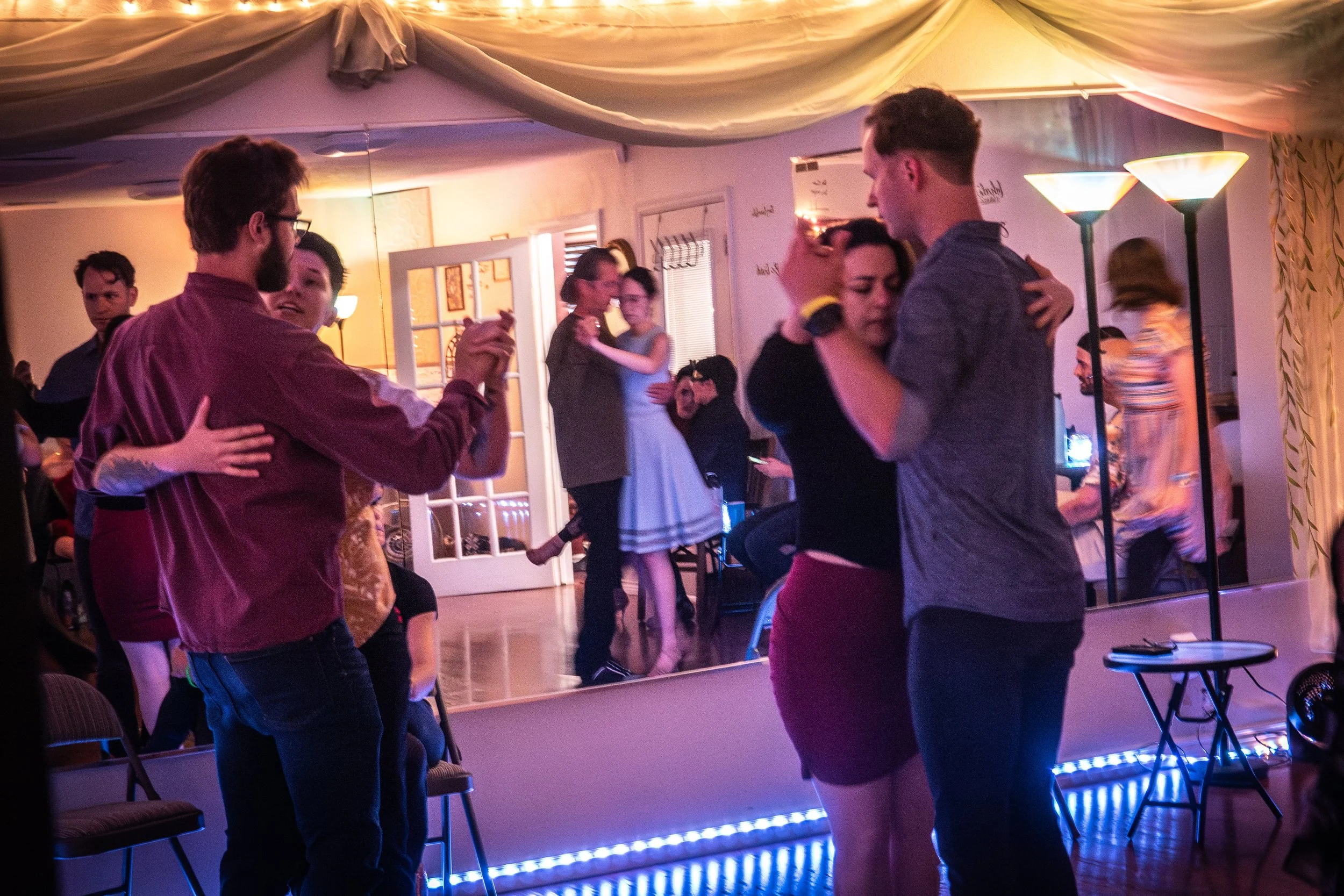How Milongas Work:
Social Dancing Expectations
How to Look Cool & Get More Dances: Etiquette
Starting when you walk in, NEVER cut directly across the dance floor. Walk around the perimeter of the room, close to seating, minding traffic.
Do not teach on the social floor; we take many classes, milongas are for enjoying what we've learned. If your partner is not executing a move as you expect, move on and practice creativity with simpler movements. Do not force the issue physically or verbally. If your partner is attempting to teach, kindly ask them to stop. The dancers whose advice you can trust do not give it on the social floor.
Experienced, respectful dancers find ways to collaborate with partners at any level and use their experience to inspire creativity, not criticism.
Minimize conversations while dancing to maximize your focus on your partner and navigation. Ongoing conversation is distracting to your partner and other dancers.
How to Ask for a Dance: Cabeceo
After the music begins to play, look for a partner using the cabeceo:
Seek to make eye contact.
After connecting, nod or make a gesture with your head/face.
Watch for a return gesture.
IF gesture is returned, the lead walks to the follow while both parties maintain eye contact.
Refusing/breaking eye contact means choosing not to dance this tanda with this person. The purpose of the Cabeceo is to support the agency of both parties and avoid embarrassment.
You Are Allowed to Say No
You may refuse a dance for any reason. You do not owe anyone an explanation. Simply be kind and clear.
"No." Is a Complete Sentence
Accept no with grace and move on. Do not coerce, convince, or otherwise negotiate when you've received a no. It is a gift to know that someone doesn't want to dance this tanda: it leaves you free to dance with someone who does. They owe you no explanation: maybe their feet are tired, maybe the music is too fast or they do not prefer this orchestra. Move on.
Understanding the Music: Tandas
Songs are played in sets of three (called a tanda). Each song in the tanda is by the same orchestra and has a similar feel. Between tandas, a short piece of non-tango music (cortina) is played to signal it is time for the lead to escort the follow back to their seat. Once you begin, it is customary to finish the tanda with the same partner.
THREE types of tango?!?!
Yep. There are three types of tango: tango, vals, and milonga. (Tango Gato offers vals and milonga workshops on a regular basis. ) The tandas are played in the following order:
Tango, tango, vals, tango, tango, milonga (repeat from the beginning)
The Fine Print
Sometimes:
Four songs are played each tanda (except Milonga & sometimes vals)
Modern orchestras or alternative tandas are added in
Sometimes, they play tango, tango, tango, vals, tango, tango, tango, milonga
DON’T PANIC!
Instead:
The moment you arrive, begin to pay attention to the music and count the songs in the tandas and number of tango tandas between special tandas.
ALWAYS wait for the cortina to play to signal the end of the tanda and escort your partner to their seat.
ALWAYS let the tanda start playing before initiating a cabeceo: just in case.
Don't Kick Your Friends: Make Friends by Not Kicking Strangers
Couples move counter clockwise around the room. Treat it like driving:
Watch existing traffic.
If the floor is busy, make eye contact to get a head nod from a leader before stepping onto the floor in front of them.
Maintain a respectful distance between you and the couple in front of you, about one step; do not tailgate.
Do not take consecutive steps backward so that you do not step on the couple behind you.
It's OK to pause and listen to the first few phrases of music and connect with your partner.
Want other perspectives?
Discover a skill that fosters
Strength - Balance - Focus
Creativity - Coordination - Agility
Connection


